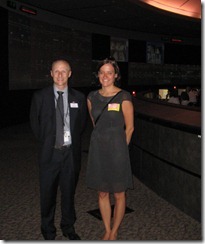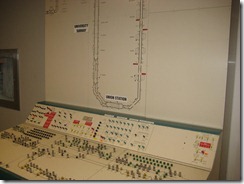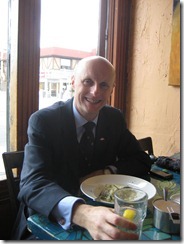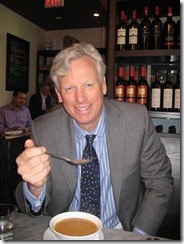Date of tour:
Tuesday, July 17, 2012
Tour background:
As a follow-up to my lunch with TTC CEO Andy Byford and my extreme transit nerdiness that was on full display in my post, Andy invited me for a tour of TTC Transit Control. And I obviously took him up on it. TTC Transit Control is located in the D.L Gunn building at the TTC Hillcrest Complex at Bathurst and Davenport. I used to live just south of Dupont on Bathurst and would hear the rumble of streetcars pass my house every night although we weren’t part of the streetcar route. I always assumed they were going to sleep for the night at Hillcrest.
The tour:
I met Andy at the gates where I was signed in and then we walked into the enormous Hillcrest Complex. The facility is much larger than it appears from the street. Andy pointed out the buildings that hold a variety of TTC departments. He then showed the garage that repairs the streetcars. Given that many of these streetcars are quite old, he said the stuff that is done in this facility in order to keep the streetcars on the road is quite amazing. It even has its own blacksmith who makes new parts.
And then we began our walk to the D.L. Gunn building, the home of TTC Transit Control. I was pretty excited. Andy told me about David L. Gunn. David used to hold the same position as Andy does today and is apparently quite a legend around the TTC. Andy says he never goes a day without hearing his name.
When we first entered the facility, you can see a remnant of the old Transit Control.
This machine did nothing to prepare me for the craziness of the room I was about to walk into.
Have you ever seen Apollo 13? Houston, we have a problem? That room in Houston is a bit like TTC Transit Control Centre, except that TTC Transit Control Centre is 100 times more awesome. You may have seen the room before with CP24’s live transit updates as they broadcast from the room. Unfortunately, pictures are not permitted in the centre for security reasons but they did let me take the one I posted above from the spot where CP24 broadcasts.
Once we walked into the room, we were met by Sean Fuller, the manager of the Transit Control Centre. He is also a former bus, streetcar and subway driver.
At the front of the room, there is a series of large screens that wrap across an entire giant wall. It begins on the left with the Yonge-University-Spadina line, then the Bloor-Danforth line, then the Sheppard line and the Scarborough RT. Facing the wall are tiered rows of desks. Each row has a different responsibility and Sean was able to walk me through each role.
As a big-time commuter, I sometimes do get frustrated with the TTC but once you stand in Transit Control and see the team at work, you get a first-hand look at how massive the system is and become quite impressed with the efficiency.
Sean walked me through the teams that watch each of the subway lines, making sure trains are on time. You can watch each individual train on the subway line and this team knows at what time each of these trains and each of these drivers need to arrive at each station.
I then met the team that sits at the communications desk. This desk handles the @TTCNotices account, as well as all of the announcements on the system regarding delays, shuttle buses, etc. It was interesting to hear how social media has really changed this role. With riders tweeting about service issues and posting photos of accidents and other problems, the communications desk is able to better respond. Although I did not get into it, I can only imagine some of the tweets this team has to sift through.
Another interesting level of Transit Control is the emergency response team. Sean told me how the TTC is the largest referrer to 911, which makes total sense when you think about it. People run into subway stations when something is wrong and report issues to the booth operator, people flag down buses to report a crime or accident and beyond this, buses and streetcars are out on the road all day and often are the first to see accidents as they drive up to them. The operators call Transit Control and this emergency response team connects with 911 and communicates with the rest of the Transit Control team.
Sean also just told me some fun facts. Because it was so hot today, trains had to slow to 40 km/h when outdoors. Subways will go around 80 km/h on a normal day along the Allen Road route. Also on very cold winter days, the subways are all stored end to end underground in the subway system in order to stay warm and away from the elements. On streetcar routes like the one along Roncy where some streetcars turn and others go straight, drivers are able to control which way they head with a lever in front of them that connects with the wires above. Also if you ever notice that trains hold slightly longer at Eglinton Station, it’s because that is the break station. The drivers get out there for a break and there is a driver who all day simply drives from Eglinton to Finch and back and then switches back with the driver when their break is over.
As I was about to leave, there was a Passenger Assistance Alarm used on a southbound train at Wellesley Station. It was incredible to watch this team in action. The reaction was so fast. First the woman watching the YUS line saw the problem, then the communication desk put out the system announcement regarding the delay, then the emergency response team connected with the train and 911 to determine is an emergency response was necessary. I think all of those things happened in under one minute.
This room was built to expand and handle additional lines and staff and will likely grow as the new LRT lines are built. It was a very cool room and seemed like a really neat place to work. I will now totally over-analyze every TTC moment of my commuting life, wondering what is going on at Transit Control.





Recent Comments